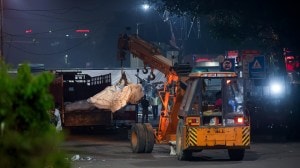Dispelling the Spooks about Nukes
• Is nuclear energy a viable source of electricity?Globally, nuclear energy accounts for 16 per cent of electricity generation. But the...

• Is nuclear energy a viable source of electricity?
Globally, nuclear energy accounts for 16 per cent of electricity generation. But there are some countries which have intensively gone nuclear, such as Lithuania (80 per cent of generation is nuclear) and France (78 per cent).
• What is the importance of nuclear energy in India?
In India, nuclear energy accounts for only 3.7 per cent of electricity generation. India today has 15 nuclear reactors with an installed capacity of 3,310 MW. There are plans to go to 20,000 MW by 2020. By comparison, China has set a target of 40,000 MW by 2020.
Over many decades, India has periodically made ambitious plans of dramatically increasing nuclear generation. But these plans have not materialised, despite massive expenditures. India’s task is harder because we have limited Uranium reserves, and have thus far been prevented from buying uranium in the world market.
• What are the strategic dimensions of energy consumption?
India faces important political and strategic difficulties associated with reliance on imported crude oil. Within five to 10 years, as much as 90 per cent of India’s oil consumption might be imported. To the extent that nuclear generation goes up, the overall energy mix will shift in a direction that reduces India’s political and strategic risks associated with consuming imported crude oil.
At the same time, there are also strategic dimensions to going nuclear. India does not have access to the best reactor design used in electricity generation, which is the ‘‘Pressurised Water Reactor’’ (PWR) technology. PWR is the commonest type of reactor worldwide, with 230 reactors in use today.
Even if India could buy PWR reactors from Western vendors, India does not have Uranium ore. Moreover, India does not presently have plants doing enrichment from 1 per cent U-235 (found in nature) to the 4 per cent level required for the PWR reactor.
• What are the logistics?
The physical size of raw material requirements is remarkably puny. A 1,000 MW plant running at 80 per cent capacity utilisation consumes just 22.2 tonnes of fuel per year.
India does not yet know how to make the large state-of-the-art reactors that are being used worldwide, which enjoy economies of scale and hence have the best cost structure. The typical PWR reactor worldwide ranges from 900 MW to 1500 MW. For a comparison, in March 2005, India commissioned a 540 MW plant at Tarapur.
Finally, of course, there is the generic issue that global vendors have made hundreds of reactors, while Indian engineers have only made a few, so,there is an inevitable technological gap that comes from inexperience. While India can claim an important achievement of knowing how to make nuclear reactors, that is very different from making the safest and cheapest reactors in the context of a competitive market.
• What is the economics of nuclear power?
The economic viability of nuclear generation could be fundamentally altered if we are able to switch from domestically produced reactors to global quality. On the other hand, if our scientists and engineers are able to rapidly learn the game, we could be exporting reactors. In either event, decisions about nuclear deployment should be rooted in commercial judgments about obtaining the cheapest prices through global competition.
India can solve these twin problems, of access to superior reactors and of access to uranium, through strategic initiatives aimed at addressing the concerns of global powers who are focused on non-proliferation.
• What’s India’s new nuclear deal with the US?
The nuclear energy agreement with the US commits India to separate military and civilian nuclear facilities, like the nuclear weapon states do. India will provide the International Atomic Energy Agency a list of civilian facilities and allow inspection of these civilian facilities placing them under safeguards, in return for which India will get access to nuclear technology, equipment and fuel.
The essence of this deal is to separate out nuclear weapons work from electricity generation. India will be fully able to produce nuclear bombs — if deemed necessary — using one or two secretive, non-commercial laboratories. But the bulk of nuclear applications in electricity generation will be treated like an ordinary industry, with a focus on commercial viability and safety. This decoupling of nuclear applications in electricity generation will make it possible to do decision-making on electricity generation purely on commercial considerations.
• How do the costs of nuclear and coal power compare?
When comparing nuclear against coal-fired plants, a comprehensive estimation of all life-cycle costs should be conducted. This should include costs of extraction and handling of fuel, capital costs, as well as costs associated with safety, chemical or radioactive pollution and the processing of waste. Normal market processes suffer from improper and incomplete reckoning for many of these aspects. For example, coal resources in the earth, or uranium resources in the earth, are generally not priced correctly.
Particularly in India, commercial principles are not being used in the computing the capital cost of nuclear plants. It is not easy to distinguish the public good of R&D by state-run labs, from the clearly visible financial structure of a generation plant. By contrast, coal plants are now being put up by the private sector, and their financial structure is visibly identifiable and can be judged based on commercial considerations.
Coal-fired plants generate a very high degree of pollution, including radioactive gases, dust and particularly CO2. Coal-fired thermal plants often generate more radiation than nuclear-fired thermal plants. And if global warming becomes a serious issue, and coal-fired thermal plants have to pay in order to pollute, their costs would go up considerably. Nuclear plants should be charged the full cost of their waste handling, which requires facilities designed for 50,000 years of isolation of the waste.
• What are the safety issues associated with nuclear generation?
The Chernobyl disaster is high on the minds of anyone thinking about nuclear electricity. After the 9/11 attacks, there has been a careful exploration, worldwide, of threats such as truck bombs or 747 planes crashing into nuclear reactors. It is now believed that these threats are adequately addressed by safety procedures.
The Indian nuclear establishment is relatively inexperienced in safety issues, and fairly non-transparent. There may be much to gain by adopting international practices on questions of safety.
The writer can be reached at: ilapatnaikexpressindia.com





- 01
- 02
- 03
- 04
- 05


























